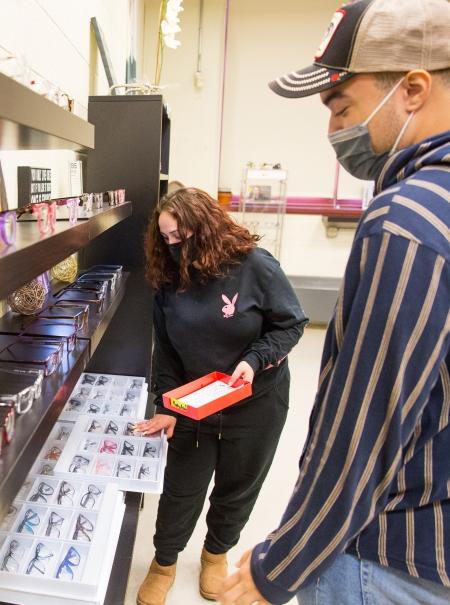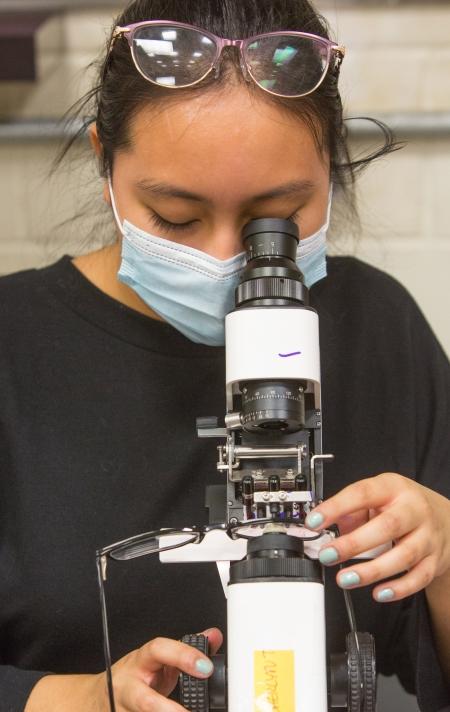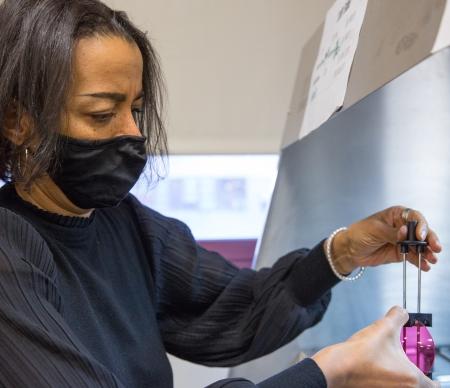
A vision technology student at Co-op Tech in Manhattan helps a schoolmate choose an eyeglass frame in the “store” created by teacher Tisha Gomez.
Jennifer, a student at the School for Cooperative Technical Education on the Upper East Side, recently chose an eyeglass frame in the school’s vision technology suite. Ninety minutes later, while working in the automotive program, she got the call: Her glasses were ready.
Each day, teacher Tisha Gomez and her students in the vision program give the gift of sight, free of charge.
“We make a difference every single day,” said Gomez, a licensed optician and the afternoon dean at the District 79 school, which serves high school, high school equivalency and post-graduate students ages 17–21 from around the city in multiple career and technical education (CTE) programs.
Just then, Mauricio, a student in the solar program, stopped by to rave about his own new specs. “Is this a one-shot deal,” he asked, “or can we get seconds?”
As Gomez was acknowledging it’s always good to have a spare pair, a school safety agent from the nearby HS for Climate Justice arrived carrying lenses in his hand, hoping to help a boy whose frame had broken.
Just a day in the life of vision tech.
“I’ve been at the school since 1989, and I’ve seen programs come and go,” said Fred Fernandez, a carpentry instructor and dean. “The vision program provides a distinct, palpable benefit to the community at large. Students come in for glasses for their parents, there’s the school across the street, you have the NYPD that comes in, not to mention staff.”
After someone has an eye exam, Gomez and her students do the rest, helping fit and dispense the lenses. “I teach them about customer care and how to fill prescriptions,” she explained. “The students help you choose a frame based on your prescription. They counsel you on the best lens, coatings, tints, any specialty lenses, including transition and progressive lenses. They take measurements. Then your lenses are ordered and cut to fit that frame and those measurements.”
A teacher for 26 years, Gomez is a graduate of the Success Via Apprenticeship program, which prepares graduates of CTE high schools to become CTE teachers. She has been doing this work since she was 13 and a student at Westinghouse HS in Brooklyn. When classmates started asking her for help, Gomez said, “My teacher was watching. He said, ‘You would be really good at this, the way you explain things, the way your hand skills are.’”
She taught at Westinghouse, Grace Dodge CTE HS in the Bronx and now at Co-op Tech for the last nine years.
“Across the city, how many children cannot see well?” Gomez asked. “Their families might not be able to afford (eye care), or they don’t realize their child can’t see, and the child is not progressing in school. If you can’t see well, you can’t see the board, you can’t read, you can’t write.”
Gomez does what she can to help.
“I always set up a vision center; part of my classroom is literally a store. I use the term ‘store’ so people understand they can come in and choose eyewear,” she said. “We have a tremendous lens inventory and, whatever I don’t have, my school has graciously allowed me to purchase.”
Gomez said, “It’s hard to do pro bono work without a doctor,” so this year she formed a partnership with Helen Keller International, which has a contract with the city Department of Education for vision screening in schools. A doctor visited Co-op Tech four times over the summer and has visited once every month since. During the last visit, 70 patients were seen.
“I have a facility here. If you give us the prescriptions, my kids will cut the eyewear,” Gomez said. “Since July, my students have produced about 350 pairs of eyeglasses.”
Students are drawn to the vision program for many reasons: Jannon, 19, says it’s practical, with a balance of working with people and doing hands-on work alone. Sherlyn, 18, whose family has a history of eye problems, says it’s gratifying to better understand those problems and maybe help solve them.
Some students have part-time jobs in the industry through partnerships with optical stores. Others get paid to fill prescriptions in Gomez’s after-school program. Some focus on collecting working hours to qualify to take the state licensing exam to become an optician. But even those who don’t choose to get a license can earn from $18 to $30 an hour, depending on the work, after finishing the program.
Her students say Gomez is patient and good at keeping them on task. She quickly gets them job-ready. Most important, she prepares them for the future: “Every time she gives a lesson, she makes it relatable to any type of situation,” said Sherlyn.
Gomez’s contribution to the school and the students “has been immeasurable, invaluable,” said Fernandez, her colleague.
Almost everyone either needs or wants eyewear at some point. “This is a multi-billion-dollar industry,” Gomez said. “My kids have a jump start.”

